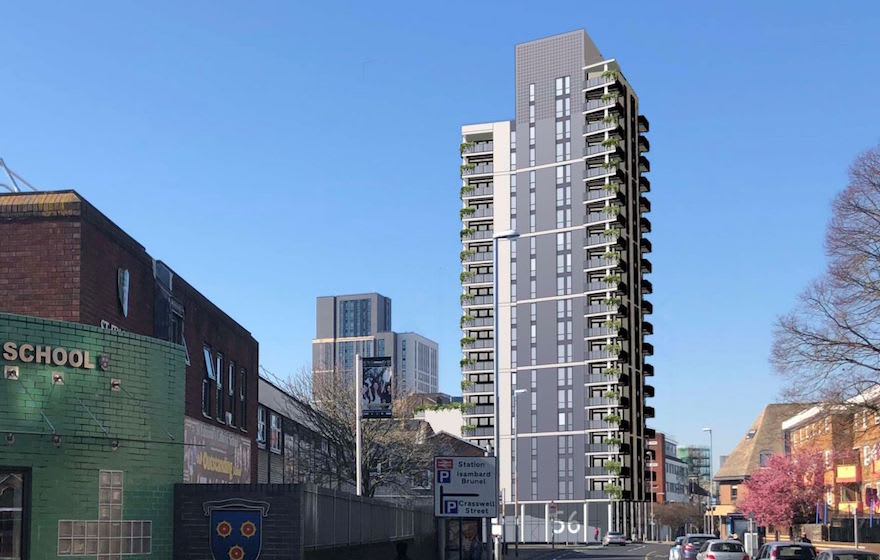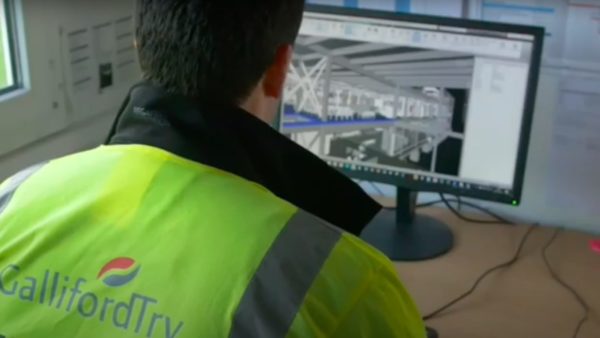Portsmouth City Council is in the vanguard of adopting BIM and digital asset management among local authorities. Femi Olaiya, Portsmouth City Council’s BIM lead and architectural design manager, tells Denise Chevin how he’s gradually overcoming the scepticism, breaking down the siloes and bringing together different departments to lay the foundations for whole-life digital asset management.
For many digital construction evangelists, the lack of enthusiasm from clients in both the public and private sector to embrace BIM and use information available to manage their assets digitally has proved a frustratingly missing piece of the jigsaw. Lack of joined-up operations between the development arms and the facilities management teams is often cited as the key obstacle to progress, with FM teams being handed information they don’t need or understand, even if they are willing to take on digital assets.
At Portsmouth City Council (PCC), Femi Olaiya is leading an ambitious initiative to break down such obstacles and ensure that the buildings it develops come with precisely the digital information management that teams need to drive efficiencies and deliver better performance of their assets.
Olaiya, BIM lead and architectural design manager in the council’s Strategic Development Department, acknowledges that traditional siloed working is not making the task easy, and his experience demonstrates how difficult it can be for large and complex organisations to make the change. But he is steadily winning the battle to convince colleagues that the benefits will make all their efforts to implement a more joined up way of working worthwhile. So far he’s developed a BIM framework that’s being used in the procurement of a number of new buildings and taken a leaf out of London’s book and commissioned an interactive digital model of the city – using the Vu City platform.
Portsmouth’s Strategic Development department is responsible for the council’s £1bn-plus development pipeline of residential, commercial and industrial projects. It helps that Olaiya, an architectural designer by training, has also worked in the council’s facilities management function and has an understanding of these needs. Altogether the council has 17,000 properties made up of homes, schools and commercial buildings, which its building services team is responsible for maintaining.

I’ve been trying to explain how important it is for asset managers to really think about the information they need.– Femi Olaiya, Portsmouth City Council
Where are you now?
We’re still at the very start of our journey with BIM, and there are lots of obstacles in terms of trying to convince stakeholders within the organisation, and outside as well, but we are making progress
I’m putting in place a system where we can make the best use of our data, in a way that is more beneficial when the building is in operation.
It’s a huge task for me, trying to align the asset management with this. But we’re getting there. We’re developing new asset information requirements for our tender documentation, and we want everyone to be part of that from the very beginning.
We have about four projects that are running to the BIM framework, and one of them is among the largest regeneration projects in the country, Lennox Point (see main image above).
Lennox Point is a £1bn development, which will have about 3,500 new residential developments, and it’s going to be car-free and a smart city. It’s going to have about 93,000 sq m of marine employment space as well. So it really does represent the future of Portsmouth.
We have a few residential BIM developments we’re doing as well. We’ve got a 22-storey, 76-flat residential development at Arundel Street in the heart of the city. And we’ve also got an extra-care housing scheme we’re doing as well, called Edinburgh House, with 62 new extra-care flats.
Do you currently manage assets with digital information?
I wouldn’t say we don’t use digital information. We have a bespoke database that holds all information about our assets. Everything is well documented. But it’s not based on a BIM model yet.
At the moment, we use BIM 360 for the delivery of our projects, and the management of the information when we’re carrying out the projects.
I’m working on ensuring that when the information moves from the project information model into the asset information model, we can incorporate that into the current systems we’ve got, which is a bespoke facilities management system for PCC.
This data base works perfectly well for us, we’ve got all the information we need. It gives a detailed information of all our maintainable and non-maintainable assets in our properties. It keeps an audit trail of all activities on the assets. The integration of BIM can help add a graphical information to this database.

The Arundel Street residential development: one of Portsmouth’s projects running to the BIM framework
Is being overwhelmed by information a barrier for asset managers to embrace BIM?
Exactly so. That’s what I’ve been trying to explain while saying how important it is for asset managers to really think about the information they need. We had to go with a generic best practice template to generate our asset information requirements on one of our key residential development.
But the downside of that is that it comes with a certain amount of information that will not be needed when the building is in operation. This helped get across that if asset managers provide the information they need at the very beginning, then only the information they require will be put into that BIM model and it will work better for them.
So that’s a huge task and it’s producing some difficulties trying to get all that set up. But I’m hoping that in the next few months we will have sorted it out.
How did the BIM initiative get started?
It all began with me seeing a need for it in 2016 and I embarked on some certification courses with the help of my then-manager Kevin Hudson. The implementation took effect when our assistant director Natascha McIntyre Hall joined PCC. She had a great understanding of its benefits and how it can help us shape how we work and deliver our projects. This gave rise to a series of awareness workshops.
In 2019 we started our BIM adoption and implementation work plan, and we did a viability assessment and return on investment on our potential development sites. With the support of a London-based BIM consultants, ECD Architects, three of these are now being done to the BIM framework.
In 2020 we set up a BIM working group. We’ve continued with our awareness and team focused workshops, and as I said, we’re implementing BIM on four projects now. Three – Lennox Point, Arundel Street, Edinburgh House – are in design and we’re already sharing data in a common data environment using BIM 360docs; everything is working to plan so far.
BIM will help with collaboration, internally and externally between teams and consultants. As property owners and developers, we will be able to hit our various targets and project millstones a lot quicker.– Femi Olaiya, Portsmouth City Council
Do you have BIM specialists in house?
It’s just myself, but I am looking at growing the team at some point.
The strategic development team has about 19 people and we’re part of the regeneration team, which has about 400 staff.
How does it work across the various council departments?
When I set up the working group, I went to the directors of the various departments, who each nominated one or two people from their departments, who then made up the working group.
The idea was to keep everyone up to speed with what we are doing through their various nominated individuals. The working comprises of individuals from key departments within the regeneration directorate and housing and neighbourhood directorate.
The key department outside of the regeneration directorate that can contribute greatly to the implementation of BIM in PCC is the building services team that cover services such as design services, building maintenance, facilities/asset management, their early involvement and understanding of the BIM process is vital.
What do you see as the main benefits?
In a nutshell, BIM will help with collaboration, internally and externally between teams and consultants. As property owners and developers, we will be able to hit our various targets and project millstones a lot quicker. It will also enable us to have a better understanding of our assets and how they perform particular when they are in operation.
The Council needs to deliver 18,000 housing units by 2036.
It will be vital to adopt BIM in order to manage all this demand that we have, and everything that we do. And it will help us put our data to better use.
How do you see digitising information about your existing stock fitting into that and complying with the Golden Thread set out in in wake of Grenfell?
About 90% of our assets are already built. So the challenge is finding efficient ways to balance the digitisation of our new developments with what already exists.
We have a system already that works. We’re a data-rich organisation, and our documentation is very good. Finding ways to translate all this data into useable information when required is where digitisation and the BIM process comes into play.
One of our most significant projects is being able to work with Vu.City to digitise 50 sq km of Portsmouth so far. This will help with planning and design decisions and also public consultations and community engagements at the early stages of our projects.
But Vu.City is just the starting point. We’ve been able to prove that we can digitise the city using Vu.City, and we can now start to gradually add on data to those blocks. If well planned, this can develop into a digital twin of our assets and it can only make operations and maintenances of our assets a lot better and more efficient.
What would you change to make things easier?
Education: devising a more strategic and creative approach in conveying the BIM message to get more stake holders onboard. There is a need to demystify the BIM myths, particularly around the cost of implementing the process versus the value it can deliver.
I will continue to work on ways to make the BIM message clearer to all parties involved. I will keep going and stay positive because the future of our industry is digital and BIM is just a piece of that puzzle.
Comments
Comments are closed.
















Good to see the BIM project being developed within Portsmouth City Council. I’d be interested to know what approach is being developed for using BIM for the many heritage assets within Portsmouth.
Thanks for your comment Charles. We are trying to figure out ways on how to balance the benefits of digitising our existing assets with the new developments. We are working closely with the building services and asset management team to see how best we can actualize this without causing much disruption to already established processes.